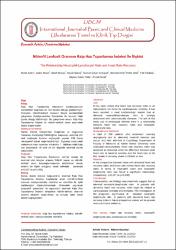| dc.contributor.author | Aydın, Murat | |
| dc.contributor.author | Akyüz, Aydın | |
| dc.contributor.author | Alpsoy, Şeref | |
| dc.contributor.author | Güneş, Hayati | |
| dc.contributor.author | Akkoyun, Dursun Çayan | |
| dc.contributor.author | Oran, Mustafa | |
| dc.contributor.author | Mete, Rafet | |
| dc.contributor.author | Tülübaş, Feti | |
| dc.contributor.author | Yıldız, Zeynep Deniz | |
| dc.contributor.author | Gürel, Ahmet | |
| dc.date.accessioned | 2017-08-03T10:51:46Z | |
| dc.date.available | 2017-08-03T10:51:46Z | |
| dc.date.issued | 2013 | |
| dc.identifier.uri | https://hdl.handle.net/20.500.11776/2216 | |
| dc.description.abstract | Amaç Kalp Hızı Toparlanma İndeksinin kardiyovasküler mortalitenin bağımsız bir risk faktörü olduğu gösterilmiştir. Yükselen nötrofil-lenfosit oranının birçok epidemiylojik çalışmada Kardiyovasküler hastalıklar ile kuvvetli ilişki içinde olduğu bildirilmiştir. Bu çalışmanın amacı Kalp Hızı Toparlanma İndeksi ile nötrofil-lenfosit oranı arasındaki ilişkiyi araştırmaktır Materyal ve Metod Namık Kemal Üniversitesi Araştırma ve Uygulama Hastanesi Kardiyoloji Polikliniği’ne, başvuran, anormal efor testi nedeniyle koroner anjiyografi yapılan 238 hasta retrospektif olarak değerlendirilmiştir. Egzersiz sırasındaki maksimum kalp hızından istirahatın 1. dakikasındaki kalp hızı çıkartılarak 18 atım ve altı değerler anormal olarak kabul edildi. Bulgular Kalp Hızı Toparlanma İndeksinin normal olanlar ile anormal olan bireyler arasıda Nötrofil sayısı ve nötrofillenfosit oranı karşılaştırılmasında istatistiksel olarak anlamlı bir ilişkili olduğunu tespit edilmiştir. (sırasıyla p=0,027 ve p=0.000). Sonuç Sonuç olarak mevcut bulgularımız anormal Kalp Hızı Toparlanma İndeksli hastalarda artan nötrofil-lenfosit oranının kardiyovasküler mortalite ve morbidite ile ilşkili olabileceğini düşündürmektedir. Gelecekte yapılacak prospektif çalışmalar ile egzersizin anormal Kalp Hızı Toparlanma İndeksli bireylerde nötrofil-lenfosit oranının üzerine etkisinin araştırılması bu konuda daha kesin deliller sağlayacaktır. | en_US |
| dc.description.abstract | Aim It has been shown that heart rate recovery index is an independent risk factor for cardiovascular mortality. It has been reported in most epidomiologic studies that an elevated neutrophil-lymphocyte ratio is strongly associated with cardiovascular diseases. The aim of this study was to investigate whether there is a relationship between heart rate recovery index and neutrophillymphocyte ratio. Materials and Methods A total of 238 patients who underwent coronary angiography due to abnormal treadmill exercise test results and who admitted to Cardiology Department of Faculty of Medicine at Namık Kemal University were evaluated retrospectively. heart rate recovery index was accepted as abnormal when the difference between peak heart rate at maximal exercise and the heart rate at the first minute of recovery phase is 18 beat or less. Results In the comparison between those with abnormal heart rate recovery index and those with normal heart rate recovery index in terms of neutrophil count and neutrophillymphocyte ratio was found a significant relationship. (respectively, p=0,027 ve p=0.000). Conclusion Consequently, our findings may potentially suggest that an elevated neutrophil-lymphocyte ratio in patients with abnormal heart rate recovery index might be related to cardiovascular mortality and morbidity. The investigation of the prognostic significance of elevated neutrophillymphocyte ratio in patients with abnormal heart rate recovery index in future prospective studies will be provide more conclusive evidence. | en_US |
| dc.language.iso | tur | en_US |
| dc.publisher | Namık Kemal Üniversitesi, Tıp Fakültesi | en_US |
| dc.rights | info:eu-repo/semantics/openAccess | en_US |
| dc.subject | Kalp hızı toparlanma İndeksi | en_US |
| dc.subject | nötrofillenfosit oranı | en_US |
| dc.subject | kardiyovasküler mortalite | en_US |
| dc.subject | Heart rate recovery index | en_US |
| dc.subject | neutrophillymphocyte ratio | en_US |
| dc.subject | cardiovascular mortality | en_US |
| dc.title | Nötrofil Lenfosit Oranının Kalp Hızı Toparlanma İndeksi İle İlişkisi | en_US |
| dc.title.alternative | The Relationship Neutrophil-Lymphocyte Ratio and Heart Rate Recovery | en_US |
| dc.type | article | en_US |
| dc.relation.ispartof | Namık Kemal Tıp Dergisi (International Journal of Basic and Clinical Medicine) | en_US |
| dc.department | Fakülteler, Tıp Fakültesi, Dahili Tıp Bilimleri Bölümü | en_US |
| dc.authorid | 26869 | en_US |
| dc.authorid | 124416 | en_US |
| dc.authorid | 135110 | en_US |
| dc.authorid | 109121 | en_US |
| dc.authorid | 108485 | en_US |
| dc.authorid | 184474 | en_US |
| dc.authorid | 163640 | en_US |
| dc.authorid | 104687 | en_US |
| dc.authorid | 9987 | en_US |
| dc.identifier.volume | 1 | en_US |
| dc.identifier.issue | 2 | en_US |
| dc.identifier.startpage | 107 | en_US |
| dc.identifier.endpage | 111 | en_US |
| dc.relation.publicationcategory | Makale - Ulusal Hakemli Dergi - Kurum Öğretim Elemanı | en_US |



















